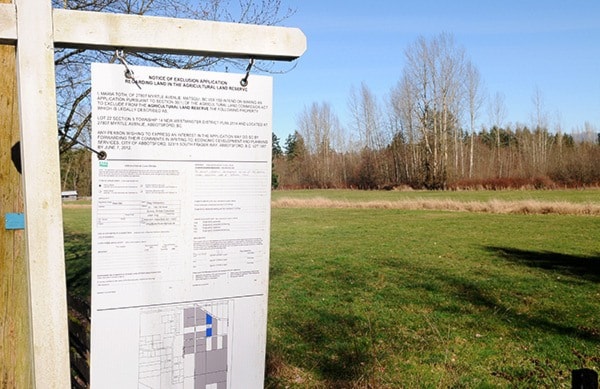Two long-standing proposals to turn farmland into industrial parks have been given new life by the draft of the city’s new Official Community Plan, which was presented to council for the first time Monday.
The draft OCP suggests creating four “Special Study Areas” where the removal of farmland from the Agricultural Land Reserve could be considered.
Two of those areas – one in Bradner, adjacent to the Gloucester industrial park in Langley, and the other just north of Abbotsford Industrial Airport – would be eyed as sites for future industrial development. The other two are suggested as possible sites for sports fields.
The Special Study Area north of the airport had been part of a sprawling request made by the city to the ALR in 2004 as part of the City in the Country Plan (CICP). While the ALR permitted the removal of hundreds of acres of land at the time, it deferred or rejected the removal of those lands that now make up the Special Study Area.
The Bradner area was the subject of a private developer’s recent application to the Agricultural Land Commission (ALC) to remove 224 acres from the ALR. The plan – which was opposed by many local residents – was denied, in part, because the ALC said it preferred to have municipalities shape such large-scale proposals.
Mark Neill, the city’s director of community planner, said the city will undertake an “industrial land supply study” after completion of the OCP in May. With a dramatic uptick in building on the CICP lands in recent years, the city expects industrial development to exhaust those properties within the lifetime of the OCP. The study will examine how much new land will be required. That outcome will guide a subsequent submission to the Agricultural Land Commission, which would have the final say on the matter.
While the ALC generally requires any removal of ALR to not have a negative impact on agriculture, it can take into account a “community benefit,” when making its decision. The city could also attempt to match any local harm to agriculture by improving land elsewhere. The CICP, for example, saw the creation of an Agriculture Trust that received $20,000 for every acre removed from the ALR.
The draft OCP also specifies farmland in two Special Study Areas that could be removed for the ALR in order to make way for a “large, city-wide active park space to serve the broader community.” Such a park – which would include playing fields and amenities for a range of sports and activities – would require a significant amount of land.
The draft suggests two such areas: one located on farmland immediately south of DeLair Park, just west of the Whatcom Road Highway 1 exit; the other on farmland immediately to the east of the University of the Fraser Valley.
Neill said any proposal to the ALR would only follow an update to the city’s Parks and Recreation Master Plan. The draft OCP notes that the areas would also be appropriate for “agricultural related uses that are more accessible to the public, community groups and students; and for agricultural exhibition, research and development and education.”
The area near the university had been part of the CICP proposal to the ALR. While the ALC declined to remove the lands at the time, it suggested it could take a second look if the University of the Fraser Valley were to play a role in a future application.
